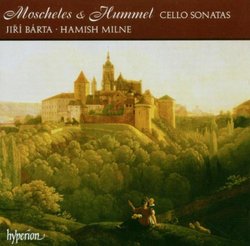| All Artists: Johann Nepomuk Hummel, Ignaz Moscheles, Hamish Milne Title: Moscheles, Hummel: Cello Sonatas Members Wishing: 0 Total Copies: 0 Label: Hyperion UK Original Release Date: 1/1/2006 Re-Release Date: 5/9/2006 Album Type: Import Genre: Classical Styles: Chamber Music, Historical Periods, Baroque (c.1600-1750), Classical (c.1770-1830), Instruments, Strings Number of Discs: 1 SwapaCD Credits: 1 UPC: 034571175218 |
Search - Johann Nepomuk Hummel, Ignaz Moscheles, Hamish Milne :: Moscheles, Hummel: Cello Sonatas
 | Johann Nepomuk Hummel, Ignaz Moscheles, Hamish Milne Moscheles, Hummel: Cello Sonatas Genre: Classical
|
Larger Image |
CD Details |
CD ReviewsTHOROUGHLY MODERN MOSCHELES DAVID BRYSON | Glossop Derbyshire England | 01/20/2007 (5 out of 5 stars) "It is always a pleasure (to me anyway) to be reminded that Beethoven Schubert and Weber were not the only good composers born between 1770 and 1799. My own recorded collection of works by Moscheles is very modest indeed, my collection of Hummel slightly better, but here is an opportunity to improve that situation. On top of that I am more than pleased to welcome two fine performing artists for the first time into my home. Jiri Barta is eminent already among the young cellists of his generation: professor Hamish Milne's work, never high-profile but always high-quality, has been known to me for many years now.
It may help in recommending this disc to newcomers if I say right away that these performances use modern and not `period' instruments. This is particularly significant where the piano is concerned, because both these composers were pianists, indeed they were among the most notable piano virtuosi of their day. Hummel's piano sonatas are conspicuously difficult even for the formidable players of today, and in spite of his reported preference for instruments possessing a light tone they respond well to a full-blooded modern treatment, as you may hear in the outstanding disc of them that Stephen Hough has done. His cello sonata here is less grandiose in tone than those are, but in the finale particularly I hear some of the special characteristics of his piano style that I have come to know and enjoy, and they are brought off effortlessly by Milne. In both sonatas the performers seem to me to judge their approach very well, neither playing the music down nor overstating it. It is thoroughly beautiful music all the way, full of melody and harmonic interest, and I think I can dare claim that I would have admired it even if I had not known that Schumann and Mendelssohn also admired it. In passing, may I refer you to a typically gushing notice (cited in the liner note) by Schumann of a joint concert given by Moscheles and Mendelssohn. The accompanying portrait of Moscheles is not one you would mistake for Mendelssohn at a second glance, but you might, as I almost did, at a first. Besides the two sonatas there is a very interesting curiosity here - three of the ten arrangements of preludes from Bach's 48 that Moscheles made with a cello part of his own. His idea was ostensibly to make Bach more accessible to the musical public, and I'm inclined to believe him. I'm not prepared to say in this review what I actually think of these efforts, because this is a review of the performance and the production, not of the music as such, and I have read too much opinionated comment, some by very distinguished people, of similar adaptations by other composers. Moscheles himself invokes Schumann and Mendelssohn as precedents, they having provided piano accompaniments to Bach's unaccompanied violin music. Very well, I'll go along with him if the parallel is supposed to be along the lines of bringing Bach to the musical multitudes, and I will acquit him of any suggestion that what Schumann and Mendelssohn were doing was in any way comparable to adding melodies to Bach's serene and abstract harmony. That is what Moscheles is doing here, and what it much more resembles is Gounod's Ave Maria. Tovey predictably dumped on any efforts by lesser lights to do anything with Bach except venerate him, but even Shaw, who might have been expected to show more independence of mind, excoriated Grieg for adding a second piano part to sonatas by Mozart in an explicit attempt to make people listen to Mozart, not to `improve' Shaw's musical deity. You can hear that in a marvellous set from Argerich and her young protégés at her Lugano festival in 2005, and you do not need me (or Shaw) to tell you what to think about it. Likewise all you need me for as regards Moschleles' arrangements of Bach is to advise that the performances seem excellent to me. The recorded sound likewise gives me no grounds for complaint, either in the Bach arrangements or in the two sonatas. In unfamiliar music such as this the comment in the liner note is more significant than in, say, the 489th complete set of Beethoven piano sonatas. The author of this particular note is the dependable if slightly uninspired John Warrack, and he gives us some useful background even if his stuff on the music is a touch platitudinous. I shall restrict my own platitudes to saying that this music is never less than interesting and enjoyable, and that the two sonatas could not unreasonably be called distinguished. I have already mentioned the likeness of Moscheles that is included. There is one of Hummel too, but not the profile that I'm used to but a full-face study that strongly recalls Ronald Reagan. This perceived resemblance does not affect my response to this fine set in any way, and I always try to recommend productions of this kind to a music-loving public which may benefit from them as I do myself." |

 Track Listings (10) - Disc #1
Track Listings (10) - Disc #1